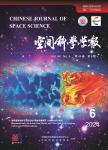Mid-Latitude Pc1, 2 Pulsations Induced by Magnetospheric Compression in the Maximum and Early Recovery Phase of Geomagnetic Storms
Mid-Latitude Pc1, 2 Pulsations Induced by Magnetospheric Compression in the Maximum and Early Recovery Phase of Geomagnetic Storms作者机构:Institute of Solar-Terrestrial Physics Siberian Branch Russian Academy of Sciences Irkutsk 664033RussiaInstitute of Solar-Terrestrial Physics Siberian Branch Russian Academy of Sciences Irkutsk 664033Russia
出 版 物:《空间科学学报》 (Chinese Journal of Space Science)
年 卷 期:2005年第25卷第5期
页 面:406-411页
核心收录:
学科分类:070802[理学-空间物理学] 07[理学] 0708[理学-地球物理学]
基 金:Supported by the China-Russia Joint Research Center on Space Weather Chinese Academy of Sciences
摘 要:We investigate the properties of interplanetary inhomogeneities generating long-lasting mid-latitude Pc1, 2 geomagnetic pulsations. The data from the Wind and IMP 8 spacecrafts, and from the Mondy and Borok midlatitude magnetic observatories are used in this study. The pulsations under investigation develop in the maximum and early recovery phase of magnetic storms. The pulsations have amplitudes from a few tens to several hundred pT and last more than seven hours. A close association of the increase (decrease) in solar wind dynamic pressure (Psw) with the onset or enhancement (attenuation or decay) of these pulsations has been established. Contrary to high-latitude phenomena, there is a distinctive feature of the interplanetary inhomogeneities that are responsible for generation of long-lasting mid-latitude Pc1,2. It is essential that the effect of the quasi-stationary negative Bz-component of the interplanetary magnetic field on the magnetosphere extends over 4 hours. Only then are the Psw pulses able to excite the above-mentioned type of mid-latitude geomagnetic pulsations. Model calculations show that in the cases under study the plasmapause can form in the vicinity of the magnetic observatory. This implies that the existence of an intense ring current resulting from the enhanced magnetospheric convection is necessary for the Pc1, 2 excitation. Further, the existence of the plasmapause above the observation point (as a waveguide) is necessary for long-lasting Pc1 waves to arrive at the ground.




